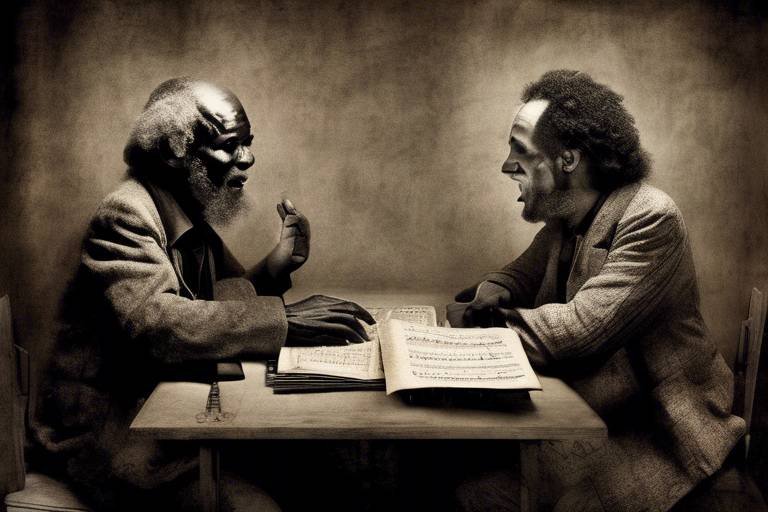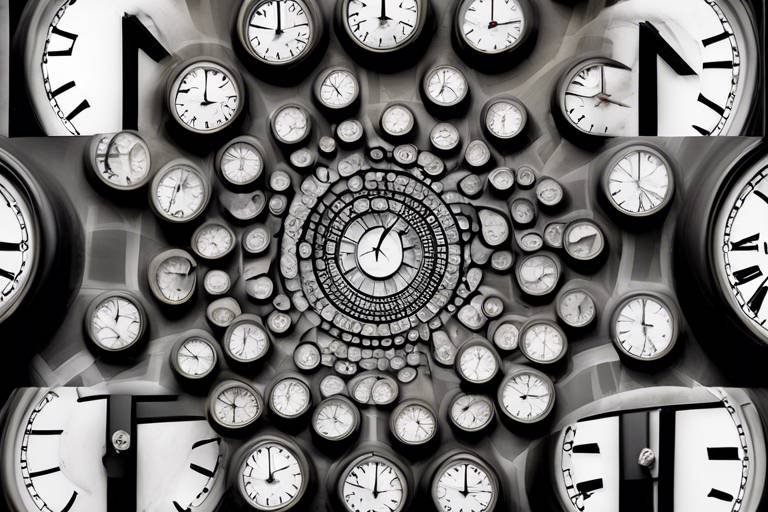Decoding the Layers of Philosophical Aesthetics
Welcome to the fascinating world of philosophical aesthetics, where we embark on a journey to uncover the intricate layers that shape our understanding of beauty, art, and the human experience. Imagine walking through a vibrant art gallery, each piece whispering its own story, inviting you to explore not just what you see, but how it makes you feel. Aesthetics isn’t just about pretty pictures or beautiful sounds; it’s a rich field of thought that digs deep into what we consider beautiful and why it matters. Whether you’re a casual observer or a seasoned art critic, understanding the philosophical underpinnings of aesthetics can profoundly enhance your appreciation of the arts.
The essence of aesthetics lies in its ability to provoke thought and stir emotions. It challenges us to ask questions like, What is beauty? or How does art influence our perception of reality? These inquiries have been at the heart of philosophical discourse for centuries, evolving through various historical contexts and cultural movements. From the ancient Greeks, who laid the groundwork for aesthetic theory, to contemporary thinkers grappling with the implications of digital art, the evolution of aesthetics is a reflection of our changing society and values.
As we dive deeper into this exploration, we’ll uncover how key theories in aesthetic philosophy—such as formalism, expressionism, and contextualism—have shaped our interpretations of art. Each theory offers a unique lens through which we can appreciate artistic endeavors. For instance, formalism encourages us to focus on the intrinsic qualities of an artwork, while expressionism invites us to connect emotionally with what we see. These perspectives not only influence art criticism but also enrich our personal experiences with art and beauty.
In an age where aesthetics permeate every aspect of our lives—from the design of our smartphones to the architecture of our cities—it’s essential to understand how these philosophical frameworks apply to our everyday experiences. Aesthetics is not confined to galleries and museums; it extends into the fabric of our daily lives, shaping our tastes, preferences, and even our identities. So, as we unravel the layers of philosophical aesthetics, prepare to be surprised by the depth and breadth of this captivating field.
Examining the evolution of aesthetic thought from ancient Greece to modern times, this section highlights significant philosophers and movements that have shaped our understanding of beauty and art.
This section outlines major theories in aesthetics, including formalism, expressionism, and contextualism, providing insight into how these perspectives influence our interpretation of art and beauty.
Formalism emphasizes the intrinsic qualities of artworks. This subsection discusses its principles and how it shapes our appreciation of artistic form over content.
Despite its influence, formalism has faced criticism. This part explores the arguments against it, including its neglect of context and emotional resonance in art.
This section investigates how formalism continues to impact contemporary art practices and critiques, revealing its lasting relevance in today's artistic landscape.
Expressionism focuses on the emotional experience of art. This subsection examines how this approach invites viewers to connect with artworks on a deeper, more personal level.
In a rapidly changing world, this section discusses the importance of aesthetics in contemporary society, including its role in culture, technology, and personal identity.
The rise of digital art has transformed aesthetic experiences. This subsection explores how technology reshapes our understanding of beauty and artistic expression in the digital age.
Aesthetics extends beyond art into daily experiences. This section highlights how aesthetic considerations influence our perceptions of the world around us, from architecture to fashion.
- What is the main focus of philosophical aesthetics? Philosophical aesthetics primarily explores concepts of beauty, art, and taste, examining how they shape human experience.
- How has aesthetic thought evolved over time? Aesthetic thought has evolved from ancient philosophical inquiries to contemporary discussions on digital art and cultural identity.
- Why is aesthetics important in everyday life? Aesthetics influences our perceptions and experiences, impacting everything from design choices to emotional responses to art.

The Historical Context of Aesthetics
The journey of philosophical aesthetics is akin to a winding river, flowing through the ages and shaped by the thoughts and ideas of some of the greatest minds in history. From the ancient Greeks, who laid the groundwork for our understanding of beauty, to modern theorists who challenge conventional views, the evolution of aesthetic thought is rich and complex. In ancient Greece, philosophers like Plato and Aristotle began to grapple with the nature of beauty and art. Plato, for instance, saw beauty as a reflection of a higher reality, a form that transcends the physical world. He believed that art was merely an imitation of this ideal, leading to a rather skeptical view of artistic creation. Aristotle, on the other hand, presented a more grounded perspective, emphasizing the importance of art in representing reality and evoking emotions in the audience.
As we drift further down the river of time, we encounter the Renaissance, a period that celebrated humanism and the revival of classical ideals. Artists like Leonardo da Vinci and Michelangelo not only created masterpieces that embodied beauty but also engaged in deep philosophical inquiry about the nature of aesthetics. This era marked a significant shift, as beauty began to be seen not just as a reflection of the divine but as something that could be experienced and appreciated in the physical world.
The Enlightenment brought forth new ideas, with philosophers such as Immanuel Kant proposing that aesthetic judgments are subjective yet universal. Kant argued that beauty is not merely in the object but also in the way we perceive it, introducing the notion of the "disinterested pleasure" that comes from appreciating art without any ulterior motives. This idea opened the floodgates for diverse interpretations of beauty, making way for the Romantic movement, which emphasized individual emotion and the sublime in nature and art.
In the 19th and 20th centuries, the landscape of aesthetics continued to evolve dramatically. Movements such as Impressionism and Modernism challenged traditional notions of beauty and representation. Artists began to prioritize personal expression and emotional depth over realistic depiction, leading to a more subjective approach to aesthetics. This shift is evident in the works of artists like Vincent van Gogh and later, Pablo Picasso, whose explorations of form and color pushed the boundaries of what art could be.
Today, the philosophical discourse surrounding aesthetics is more vibrant than ever, influenced by various cultural, social, and technological changes. The rise of postmodernism has further complicated our understanding of beauty, questioning the very foundations of aesthetic value and suggesting that meaning is constructed rather than inherent. As we navigate this complex terrain, it becomes clear that the historical context of aesthetics is not just a backdrop but a living dialogue that continues to shape our perceptions of art and beauty.
In conclusion, the historical context of aesthetics is a rich tapestry woven from the thoughts of philosophers and artists across centuries. Each era contributes its unique thread, creating a complex narrative that informs our contemporary understanding of beauty and art. As we continue to explore these ideas, we must remember that aesthetics is not a static field but a dynamic conversation that evolves with society.
- What is philosophical aesthetics? - Philosophical aesthetics is the branch of philosophy that deals with questions of art, beauty, and taste, exploring how we perceive and interpret aesthetic experiences.
- Who are some key philosophers in aesthetics? - Key philosophers include Plato, Aristotle, Immanuel Kant, Friedrich Schiller, and more contemporary thinkers like Arthur Danto and George Dickie.
- How has aesthetics evolved over time? - Aesthetics has evolved from ancient reflections on beauty to modern debates about subjectivity, representation, and the impact of technology on art.

Key Theories in Aesthetic Philosophy
Aesthetics, the philosophical study of beauty and taste, is rich with diverse theories that have evolved over centuries. These theories not only shape our understanding of art but also influence how we perceive beauty in everyday life. Among the most prominent theories are formalism, expressionism, and contextualism. Each of these perspectives offers unique insights into the nature of art and the criteria we use to evaluate it. Let's dive deeper into these key theories and see how they interconnect with our appreciation of artistic endeavors.
Formalism is a theory that emphasizes the intrinsic qualities of artworks, focusing on elements such as color, line, shape, and texture. According to formalists, the value of a piece lies in its form rather than its content or context. This perspective encourages viewers to engage with art on a purely visual level, stripping away any external narratives or emotional associations. For instance, when observing a painting, a formalist might ask questions like:
- What colors are used?
- How do the shapes interact with one another?
- What is the overall composition like?
By concentrating on these aspects, formalism invites us to appreciate the craftsmanship behind an artwork, allowing us to recognize the skill involved in creating visually compelling pieces. However, this approach also raises questions about the limits of artistic interpretation. Can we truly appreciate art without considering its emotional and contextual dimensions?
Despite its significant influence, formalism has faced considerable criticism. Detractors argue that this theory neglects vital elements like context and emotional resonance, which are essential for a comprehensive understanding of art. Critics assert that focusing solely on form can lead to a superficial appreciation of art, disregarding the stories and feelings that artworks often convey. For example, consider a powerful painting that depicts a historical event. While a formalist might admire the brushwork, a contextualist would argue that understanding the historical background is crucial to fully grasp the artwork's significance. This critique highlights the limitations of formalism in fostering a deeper connection between the viewer and the artwork.
Even in today's artistic landscape, formalism continues to play a pivotal role. Many contemporary artists draw inspiration from formalist principles, exploring the boundaries of form and abstraction. Artists like Donald Judd and Agnes Martin have created works that emphasize geometric shapes and color fields, challenging viewers to engage with art on a purely aesthetic level. Their contributions demonstrate that while formalism may be critiqued, its relevance persists in the ongoing dialogue about art and beauty. As we navigate through the complexities of contemporary art, formalism serves as a reminder that sometimes, the beauty of art lies in its ability to captivate us visually, without the need for elaborate narratives.
On the other end of the spectrum lies expressionism, a theory that champions emotional experience as the core of artistic value. Expressionists believe that art should evoke feelings and provoke thought, encouraging viewers to connect with the artwork on a personal level. This approach invites us to explore our own emotions and experiences as we engage with art. For instance, a powerful expressionist painting might elicit feelings of joy, sadness, or even anger, allowing viewers to reflect on their own emotional journeys.
Expressionism also emphasizes the artist's intent and emotional state during the creation process. By understanding the artist's perspective, we can gain deeper insights into the meaning behind the work. This theory reminds us that art is not merely a visual experience; it is a portal into the human condition, allowing us to share in the joys and struggles of others.
In summary, the key theories in aesthetic philosophy—formalism and expressionism—offer contrasting yet complementary perspectives on art and beauty. While formalism invites us to appreciate the intrinsic qualities of artworks, expressionism encourages emotional engagement and personal connection. Understanding these theories enriches our appreciation of art, allowing us to navigate the complex landscape of aesthetics with greater insight.
What is the main difference between formalism and expressionism?
The main difference lies in their focus: formalism emphasizes the intrinsic qualities of the artwork, such as form and composition, while expressionism prioritizes the emotional experience and the artist's intent behind the work.
Can art be appreciated without understanding its context?
While it is possible to appreciate art on a purely visual level, understanding its context can enhance the viewing experience and provide deeper insights into the artwork's significance.
How do contemporary artists incorporate formalism in their work?
Contemporary artists often explore formalist principles by focusing on abstract forms, geometric shapes, and color interactions, inviting viewers to engage with the visual aspects of their work without relying on narrative content.

Formalism and Its Implications
Formalism, at its core, is a fascinating approach to understanding art that emphasizes the intrinsic qualities of artworks over their contextual or emotional aspects. Imagine walking into an art gallery and being drawn to a painting not because of its subject matter or the feelings it evokes, but solely due to its colors, shapes, and composition. This is the essence of formalism. It invites us to appreciate the fundamental elements of art—lines, forms, textures, and colors—as the primary means of engaging with a piece. By stripping away the narrative or emotional layers, formalism allows for a more objective analysis of art, much like a scientist examining a specimen under a microscope.
One of the key implications of formalism is that it encourages viewers to develop a keen eye for detail. When we focus on the formal elements, we begin to notice subtleties that might otherwise go unnoticed. For instance, consider the brushwork in a Van Gogh painting; the swirling strokes create a rhythm that can be appreciated without knowing the emotional backstory of the artist. This approach can lead to a more profound appreciation of the technical skills involved in creating art, as well as an understanding of how these elements contribute to the overall aesthetic experience.
However, formalism is not without its limitations. Critics argue that by prioritizing form over content, we risk losing sight of the contextual richness of a work. Art does not exist in a vacuum; it is often a reflection of the society, culture, and personal experiences of its creator. For instance, a piece of abstract art may be visually stunning, but understanding the historical context in which it was created can deepen our appreciation and interpretation of it. Thus, while formalism provides valuable insights, it is essential to balance this perspective with an awareness of the broader implications of art.
Moreover, the implications of formalism extend into the realm of art criticism and education. Art critics who adopt a formalist approach often focus their evaluations on the technical aspects of a work, which can shape public perception and appreciation of art. In educational settings, teaching students to analyze art through a formalist lens can enhance their observational skills, enabling them to articulate their thoughts on art more clearly. However, educators must also encourage students to explore other perspectives, ensuring a well-rounded understanding of art as a multifaceted experience.
In conclusion, while formalism offers a unique lens through which to view art, emphasizing the beauty of form and technique, it is crucial to remember that art is a complex interplay of various elements, including context and emotion. The challenge lies in finding a balance between appreciating the formal qualities of art while also recognizing the rich narratives and meanings that lie beneath the surface.
- What is formalism in art? Formalism is an approach that focuses on the visual elements of art, such as color, shape, and composition, rather than the emotional or contextual aspects.
- Why is formalism important? It helps viewers develop a deeper understanding of the technical aspects of art and encourages a more objective analysis.
- What are the criticisms of formalism? Critics argue that formalism neglects the context and emotional resonance of art, which can lead to a limited appreciation of its meaning.
- How can formalism be applied in art education? Educators can use formalism to teach students to analyze and articulate their observations about art, while also encouraging exploration of other perspectives.

Critiques of Formalism
While formalism has undeniably carved out a significant niche in the world of art criticism, it hasn't gone without its share of criticism. One of the most prominent critiques revolves around its inherent neglect of context. Formalism tends to isolate the artwork from its surrounding influences, such as historical, cultural, and social factors that can greatly inform its meaning. Imagine trying to understand a painting without considering the era it was created in or the life of the artist; it’s like reading a book without knowing the plot! This isolation can lead to a superficial understanding of art, where the deeper emotional and contextual layers are overlooked.
Another significant point of contention is the formalist approach's tendency to prioritize form over content. Critics argue that this focus diminishes the role of the artist's intention and the emotional responses elicited in viewers. Art is not just about the arrangement of colors and shapes; it’s a medium through which feelings, thoughts, and cultural narratives are expressed. By sidelining these elements, formalism risks reducing art to mere aesthetics, stripping it of its rich narrative potential.
Moreover, many argue that formalism can create an elitist barrier, where only those educated in the nuances of art can truly appreciate it. This notion raises the question: should art be accessible to everyone, or is it reserved for a select few who can decode its formal elements? Such elitism can alienate the average viewer, who might feel unqualified to engage with art that is presented as a puzzle to be solved rather than an experience to be enjoyed.
In addition to these critiques, formalism has also faced challenges from emerging perspectives that emphasize the emotional resonance and cultural significance of artworks. For example, the rise of postmodernism has encouraged a more inclusive approach to aesthetics, one that embraces a variety of interpretations and encourages dialogue between the artwork and its audience. This shift highlights the importance of contextualism, which asserts that understanding art requires considering the broader social and historical frameworks in which it exists.
In summary, while formalism has played a crucial role in shaping art criticism, its limitations have sparked important debates about the nature of art itself. The critiques against formalism remind us that art is a multifaceted experience, one that encompasses not only its visual elements but also the emotions, contexts, and narratives that breathe life into it.
- What is formalism in art criticism?
Formalism is an approach that emphasizes the visual elements of art—such as color, line, shape, and composition—over its content or context. - Why is formalism criticized?
Critics argue that formalism neglects the historical and emotional contexts of art, leading to a superficial understanding and potentially alienating viewers. - What are some alternatives to formalism?
Alternatives include expressionism, which focuses on emotional engagement, and contextualism, which considers the broader social and historical influences on artworks.

Formalism in Contemporary Art
Formalism has not only left its mark on the history of art but continues to resonate within the realm of contemporary art practices. As artists and critics grapple with evolving definitions of beauty and meaning, formalism serves as a lens through which we can analyze and appreciate the intricacies of artistic form. At its core, formalism prioritizes the visual and structural elements of a work—such as color, line, shape, and composition—over the narrative or emotional content. This approach invites viewers to engage with art through a purely aesthetic experience.
In today’s art world, the influence of formalism is evident in various movements and styles. For instance, minimalist artists emphasize simplicity and the purity of form, stripping away extraneous elements to highlight the essence of their materials. Artists like Donald Judd and Agnes Martin exemplify this approach, creating works that challenge viewers to appreciate the subtleties of color and texture. Their pieces often provoke contemplation of the relationship between space and perception, showcasing how formalist principles can lead to profound insights.
Moreover, formalism's impact extends to contemporary art criticism. Critics and scholars often employ formalist analysis to dissect artworks, focusing on how the arrangement of visual elements contributes to the overall experience. This method can be particularly useful in understanding abstract art, where narrative content may be minimal or absent. By concentrating on the formal qualities of an artwork, critics can illuminate the skill and intention behind the piece, providing a deeper appreciation for the artist's craft.
However, the relevance of formalism in contemporary art is not without its challenges. In an era where artists increasingly blend various styles and media, the rigid boundaries set by formalist theory may seem restrictive. Many contemporary artists embrace a more holistic approach, integrating context, narrative, and emotional resonance into their work. This shift raises important questions about the role of formalism in a world that values diversity and complexity in artistic expression.
Despite these challenges, formalism remains a vital framework for understanding contemporary art. It encourages viewers to slow down, observe, and engage with the visual elements at play. As we navigate a landscape filled with multimedia installations, digital art, and interactive experiences, the principles of formalism offer a foundation for appreciating the nuances of artistic creation. In this sense, formalism is not just a relic of the past but a dynamic and evolving approach that continues to shape our engagement with art today.
- What is formalism in art?
Formalism is an approach to art that emphasizes the visual and structural aspects of a work over its content or context. It focuses on elements like color, line, and composition.
- How does formalism influence contemporary art?
Formalism influences contemporary art by encouraging artists to focus on the intrinsic qualities of their work, leading to movements like minimalism that prioritize simplicity and purity of form.
- Are there criticisms of formalism?
Yes, critics argue that formalism can neglect the emotional and contextual aspects of art, which are essential for a comprehensive understanding of a piece.
- Can formalism be applied to digital art?
Absolutely! Formalism can be applied to digital art by analyzing the visual elements and design principles used in the creation of digital works.

Expressionism and Emotional Engagement
Expressionism is more than just a movement in art; it's a gateway to emotional engagement. Imagine standing before a painting that seems to pulse with life, colors swirling and shapes contorting in ways that make your heart race. This is the essence of expressionism—it invites you to feel, to connect, and to experience art on a deeply personal level. Unlike formalist approaches that focus solely on the technical aspects of a piece, expressionism dives straight into the emotional core of the artwork, asking viewers to explore their own feelings and reactions.
At its heart, expressionism is about communication. Artists use bold colors, exaggerated forms, and dynamic compositions to convey their inner emotions. This approach can transform a simple canvas into a visceral experience, making you question not just what you see, but how it makes you feel. Think of Edvard Munch's "The Scream"—the swirling skies and anguished figure resonate with anyone who's ever felt anxiety or despair. It's a universal language of emotion that transcends cultural and temporal boundaries.
Moreover, expressionism encourages viewers to engage in a dialogue with the artwork. When you stand before an expressionist piece, it's like entering a conversation where your feelings are just as important as the artist's intent. This two-way interaction is crucial; it allows for a multitude of interpretations, each shaped by personal experiences and emotions. Some may find solace in the chaos of a Jackson Pollock painting, while others might feel a sense of unease. This subjectivity is what makes expressionism so powerful and relevant today.
In today's fast-paced world, where emotional connections often take a backseat to productivity, expressionism serves as a reminder of the importance of feeling. It challenges us to slow down and reflect on our emotional landscapes. Whether through the vibrant strokes of a canvas or the haunting notes of a musical composition, expressionism beckons us to embrace our feelings, making art a vital part of our human experience.
As we navigate the complexities of modern life, the emotional engagement offered by expressionism can be a form of therapy. It provides a space for catharsis, allowing us to confront our emotions in a safe environment. This connection to our inner selves is not just beneficial for individuals; it can foster collective empathy and understanding within communities. By sharing our emotional responses to art, we can bridge gaps and build connections that are often lacking in our daily interactions.
In conclusion, expressionism is more than a style; it’s a profound exploration of the human condition. It invites us to engage with art not just as passive observers but as active participants in a shared emotional journey. So, the next time you encounter an expressionist work, take a moment to pause and reflect. What emotions does it stir within you? How does it resonate with your own experiences? This is where the true power of expressionism lies—within the emotional engagement it fosters, making art a mirror reflecting our innermost selves.
- What is expressionism in art?
Expressionism is an art movement that emphasizes the expression of emotional experience rather than physical reality. It often uses vivid colors and distorted forms to convey feelings. - How does expressionism differ from formalism?
While formalism focuses on the technical aspects of art, such as composition and form, expressionism prioritizes the emotional impact and personal connection between the viewer and the artwork. - Can anyone appreciate expressionist art?
Absolutely! Expressionism is designed to resonate with a wide audience, inviting personal interpretations based on individual emotions and experiences. - How can expressionism be therapeutic?
Engaging with expressionist art can provide a cathartic experience, allowing individuals to confront and process their emotions in a supportive environment.

Contemporary Relevance of Aesthetics
In a world that is constantly evolving, the significance of aesthetics has never been more pronounced. From the way we interact with technology to how we perceive our surroundings, aesthetics plays a crucial role in shaping our experiences and identities. Imagine walking through a city where every building is a masterpiece, each street is lined with art, and even the parks are curated with beauty in mind. This is not just about visual appeal; it’s about how aesthetics influences our emotions, thoughts, and interactions. As we navigate through this digital age, the relevance of aesthetics becomes intertwined with our daily lives, impacting everything from personal expression to cultural movements.
The impact of aesthetics in contemporary society can be observed across various domains. In culture, for instance, we see a resurgence of interest in the visual arts, with movements such as street art and digital installations gaining prominence. These forms of expression challenge traditional notions of beauty and art, inviting us to reconsider what we value aesthetically. Additionally, aesthetics is deeply embedded in technology; think about how user interface design affects our experience with apps and websites. A well-designed interface not only looks good but also enhances functionality, proving that beauty and utility can coexist harmoniously.
Furthermore, aesthetics is crucial in shaping our personal identities. In an age of social media, where visual representation is paramount, individuals curate their online personas with great care, often prioritizing aesthetic appeal. This phenomenon raises questions about authenticity and the pressure to conform to certain beauty standards. As we scroll through our feeds, we are bombarded with images that evoke emotions, inspire creativity, or even provoke thought. This digital landscape becomes a canvas for personal expression, where aesthetics are not just about art but about how we present ourselves to the world.
Moreover, the relationship between aesthetics and well-being cannot be overlooked. Numerous studies have shown that exposure to beauty can enhance our mood and overall mental health. Whether it’s enjoying a breathtaking sunset, admiring a piece of art, or simply appreciating the design of a well-furnished room, aesthetic experiences can lead to feelings of joy and contentment. In this sense, aesthetics transcends mere visual appeal; it becomes a vital component of our emotional and psychological landscape.
To illustrate the contemporary relevance of aesthetics, consider the following table that highlights the various domains where aesthetics plays a pivotal role:
| Domain | Impact of Aesthetics |
|---|---|
| Cultural Movements | Challenges traditional notions of beauty, embraces diverse expressions. |
| Technology | Enhances user experience through intuitive and appealing designs. |
| Personal Identity | Influences how individuals present themselves in digital spaces. |
| Mental Health | Exposure to beauty contributes to emotional well-being. |
As we move forward, it’s essential to recognize that aesthetics is not a static concept; it evolves alongside our cultural and technological advancements. The way we perceive beauty will continue to shift, reflecting our changing values and experiences. In this dynamic landscape, aesthetics remains a powerful tool for connection, expression, and understanding, reminding us that beauty is not just in the eye of the beholder but a shared experience that binds us together as humans.
- What is the importance of aesthetics in everyday life?
Aesthetics influences our perceptions, emotions, and interactions, shaping our experiences in various environments. - How does technology affect our understanding of aesthetics?
Technology enhances aesthetic experiences through design, making art and beauty more accessible and interactive. - Can aesthetics impact mental health?
Yes, exposure to beautiful environments and art can improve mood and overall well-being. - What role does aesthetics play in personal identity?
Aesthetics influences how individuals curate their online personas and express themselves visually.

Aesthetics and Digital Art
In today's fast-paced world, digital art has emerged as a revolutionary force, reshaping our understanding of aesthetics in profound ways. Imagine stepping into a gallery where every piece of art is not just a static image but a dynamic experience that interacts with its audience. This is the essence of digital art—it's not confined to traditional mediums like paint and canvas; instead, it embraces technology to create immersive experiences that challenge our perceptions of beauty and creativity.
One of the most fascinating aspects of digital art is its ability to blur the lines between the artist and the viewer. Unlike conventional art forms, where the audience is often a passive observer, digital art invites participation. Think about it: how many times have you come across a digital installation that encourages you to touch, manipulate, or even become part of the artwork? This interactivity fosters a deeper emotional connection, allowing viewers to engage with the art on a personal level, making them feel like co-creators rather than mere spectators.
Moreover, the aesthetic possibilities in the digital realm are virtually limitless. Artists can experiment with color, form, and movement in ways that were previously unimaginable. For example, digital tools allow for the creation of 3D models, animated graphics, and even virtual reality experiences that transport viewers into entirely new worlds. This transformation in artistic expression raises intriguing questions about what constitutes beauty and how we define art in the digital age. Is a piece of art still beautiful if it evolves and changes with every interaction? Or does its transient nature diminish its aesthetic value?
To better understand the impact of digital art on aesthetics, let’s consider some key elements that differentiate it from traditional art forms:
| Element | Traditional Art | Digital Art |
|---|---|---|
| Medium | Paint, canvas, sculpture | Software, pixels, virtual environments |
| Interactivity | Passive observation | Active participation |
| Reproducibility | Limited editions | Infinite copies |
| Time | Static | Dynamic, ever-changing |
This table illustrates how digital art not only expands the definition of aesthetics but also challenges our preconceived notions about art itself. As technology continues to evolve, so too does the landscape of artistic expression. Artists are now able to leverage tools like AI, augmented reality, and interactive installations to create works that are not only visually stunning but also intellectually stimulating.
As we delve deeper into the intersection of aesthetics and digital art, we must also consider its implications for culture and society. Digital art democratizes access to artistic experiences, allowing people from all walks of life to engage with art in ways that were once exclusive to galleries and museums. This accessibility fosters a more inclusive dialogue around beauty and creativity, encouraging diverse voices and perspectives to emerge in the artistic conversation.
In conclusion, the aesthetics of digital art are not just about what we see; they're about how we feel, interact, and connect with the art. As we embrace this new frontier of artistic expression, we are not only redefining beauty but also reimagining our role as participants in the ever-evolving narrative of art. So, the next time you encounter a piece of digital art, ask yourself: how does it make you feel? What stories does it tell? And how does it challenge your understanding of beauty?
- What is digital art? Digital art refers to artistic works created using digital technology, often involving software and digital tools.
- How does digital art differ from traditional art? Digital art allows for interactivity, dynamic experiences, and infinite reproducibility, unlike traditional art which is typically static and limited in edition.
- Can digital art be considered 'real' art? Absolutely! Digital art is a legitimate form of artistic expression that challenges and expands the boundaries of what art can be.
- What role does technology play in digital art? Technology is integral to digital art, providing artists with tools to create, manipulate, and share their work in innovative ways.

Aesthetics in Everyday Life
When we think of aesthetics, we often picture grand paintings in museums or sculptures in parks, but the truth is, aesthetics permeates our everyday lives in ways we might not even realize. It's like the air we breathe; we often take it for granted until we stop and think about it. From the design of our smartphones to the architecture of the buildings we inhabit, aesthetics shapes our experiences in profound ways. Have you ever noticed how a well-designed cafe can uplift your mood? Or how a cluttered room can drain your energy? These experiences reveal the powerful influence of aesthetics on our daily lives.
Consider the spaces we occupy. Whether it's our homes, workplaces, or public areas, the aesthetic choices made in these environments can drastically affect our feelings and behaviors. For instance, a bright, open office space with natural light can enhance productivity and creativity, while a dimly lit, cramped room can lead to feelings of lethargy. This is not just about personal preference; it's about how design elements such as color, light, and layout interact to create an atmosphere that either inspires or stifles.
Furthermore, aesthetics extends into the realm of fashion and personal style. What we choose to wear is often a reflection of our identity and mood. The colors, patterns, and styles we select can communicate messages about who we are or who we aspire to be. For example, wearing bright colors might express positivity and energy, while darker tones could convey seriousness or introspection. This connection between aesthetics and identity highlights how our choices are not merely superficial; they are deeply intertwined with our self-perception and the way we wish to present ourselves to the world.
Even in the digital realm, aesthetics plays a crucial role. The design of websites and apps can significantly impact user experience. A clean, intuitive interface invites users to engage more fully, while a cluttered, confusing layout can drive them away. This is particularly important in today’s fast-paced world, where attention spans are short, and first impressions are everything. The aesthetic appeal of a digital product can be the difference between a user staying engaged or clicking away.
In essence, aesthetics is not just an abstract concept confined to the realms of art and philosophy; it is a vital component of our everyday experiences. It shapes our perceptions, influences our emotions, and even affects our interactions with others. By cultivating an awareness of aesthetics in our daily lives, we can enhance our environments, express our identities, and ultimately enrich our human experience.
- What is the role of aesthetics in personal identity?
Aesthetics helps express who we are through our choices in fashion, home decor, and even how we present ourselves in social media. - How can aesthetics influence mood and productivity?
The design of spaces, including color schemes and layouts, can significantly enhance or diminish our mood and productivity levels. - Why is digital aesthetics important?
Aesthetics in digital design affects user engagement and satisfaction, making it crucial for businesses and creators to prioritize appealing interfaces.
Frequently Asked Questions
- What is philosophical aesthetics?
Philosophical aesthetics is the branch of philosophy that examines the nature of beauty, art, and taste. It delves into questions about what constitutes beauty, how we perceive art, and the emotional responses that artworks evoke in us. This field invites us to reflect on our experiences with art and the various factors that influence our appreciation of it.
- How has the historical context shaped aesthetic thought?
The historical context has played a crucial role in shaping aesthetic thought. From the ancient Greeks, who laid the groundwork for discussions on beauty and form, to modern philosophers who challenge traditional views, each era has contributed unique perspectives. This evolution illustrates how cultural, social, and technological changes influence our understanding of aesthetics over time.
- What are the key theories in aesthetic philosophy?
Key theories in aesthetic philosophy include formalism, expressionism, and contextualism. Formalism focuses on the intrinsic qualities of artworks, while expressionism emphasizes emotional engagement with art. Contextualism considers the broader context in which art is created and experienced. Each theory offers distinct insights into how we interpret and value artistic expressions.
- What are the critiques of formalism?
Formalism, while influential, has faced significant critiques. Detractors argue that it neglects the emotional and contextual elements of art, reducing the rich experience of artworks to mere form and structure. Critics believe this approach can oversimplify the complexity of artistic expression and the varied ways individuals connect with art.
- How does expressionism enhance our emotional connection to art?
Expressionism enhances our emotional connection to art by prioritizing the feelings and experiences conveyed through artworks. This approach encourages viewers to engage with art on a personal level, inviting them to explore their own emotions and interpretations. By focusing on the artist's emotional intent, expressionism fosters a deeper appreciation of the human experience reflected in art.
- What is the relevance of aesthetics in contemporary society?
Aesthetics remains highly relevant in contemporary society as it influences culture, technology, and personal identity. In a world where visual experiences are ubiquitous, understanding aesthetics helps us navigate our interactions with art, design, and even everyday objects. It shapes our perceptions and enriches our lives by enhancing our appreciation of beauty in various forms.
- How has digital art transformed aesthetic experiences?
Digital art has transformed aesthetic experiences by introducing new mediums and possibilities for artistic expression. Technology reshapes how we create, share, and experience art, allowing for interactive and immersive experiences that were previously unimaginable. This shift challenges traditional notions of beauty and invites us to rethink our engagement with art in the digital age.
- In what ways does aesthetics influence our daily lives?
Aesthetics influences our daily lives in numerous ways, from the architecture we encounter to the fashion we wear. Our perceptions of beauty and design impact our choices and experiences, often enhancing our enjoyment of the world around us. By recognizing the aesthetic dimensions of everyday life, we can cultivate a deeper appreciation for the beauty that surrounds us.



















